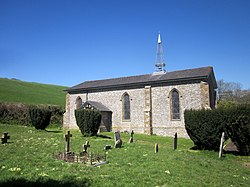Difference between revisions of "Blackdown, Dorset"
(Created page with "{{Infobox town |name=Blackdown |county=Dorset |picture=Holy Trinity Church, Blackdown (geograph 4714109).jpg |picture caption=Holy Trinity Church, Blackdown |os grid ref=ST397...") |
(No difference)
|
Latest revision as of 20:01, 15 May 2020
| Blackdown | |
| Dorset | |
|---|---|
 Holy Trinity Church, Blackdown | |
| Location | |
| Grid reference: | ST397028 |
| Location: | 50°49’20"N, 2°51’23"W |
| Data | |
| Population: | 128 (2001) |
| Post town: | Beaminster |
| Postcode: | DT8 |
| Dialling code: | 01308 |
| Local Government | |
| Council: | Dorset |
| Parliamentary constituency: |
West Dorset |
Blackdown is a small village in western Dorset; situated seven miles west of Beaminster. The main road through the village is the B3165, connecting Blackdown and Lyme Regis.
The village has a population of 128 according to the 2001.
A chapel of ease dedicated to the Holy Trinity was erected in 1840 on the site of a former chapel building which had become derelict although there are a few graves which are prior to 1840. On the night of 16 to 17 December 1961 the chapel was destroyed by a fire due to a wood-burning stove which had been lit overnight for a service the next day.
The church is in the ecclesiastical parish of Blackdown (Beaminster Team) and often combines with Burstock and Broadwindsor Churches to raise funds for their shared precept. The present building was rebuilt and rededicated in 1964; since then full church status has been acquired, and the church community look forward to holding their first marriage service in the church. One notable resident in the graveyard is John Anthony Brown, who was killed by his wife Elizabeth Martha Brown at Birdsmoregate, a small village a few miles away in 1856. Despite a plea for clemency, Elizabeth was publicly hanged at Dorchester Prison, a sight witnessed by many, including a 16-year-old Thomas Hardy, who years later asked Lady Hester Pinney who lived at Racedown House to investigate the story. It is believed that Hardy may have based his novel Tess of the d'Urbervilles on his experience.
Another branch of the Pinney family also lived at Blackdown House, and like Racedown House, they were formerly working farms. They are not open to the public. There are still several family farms in the area.
Blackdown also has a village hall, built on ground owned by the Pinney family of Racedown House. It was initially called Blackdown Hut and officially opened on 9 December 1920 by Lady Rhodes Moorhouse but like the church it was a destroyed by a fire on the 8 September 1976 but was rebuilt and reopened exactly three years later. Blackdown W.I host their monthly meetings at the Hall, founded by Lady Hester Pinney in 1917 it is one of the earliest W.I's in Dorset.
The village sits at the foot of Blackdown Hill (705 feet), one of Dorset's high points from which there are extensive views of the local area. On the opposite side of Blackdown Hill near to the hamlet of Stoney Knapp and alongside Causeway Lane is the former congregational chapel of Venn with its churchyard and just around the corner is the particular baptist Ebenezer, both are now private houses, although Thorncombe tries to claim them, they are actually situated in the parish of Broadwindsor.